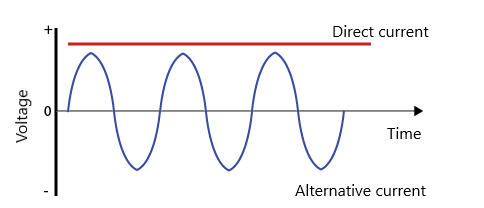What is direct current? In this article, we will learn about the concept of direct current and its properties.
DC current was created in 1800 by Italian physicist Alessandro Volta. Technology is advancing in the realm of solar-electric energy; someday a significant part of our electricity might come from photovoltaic power plants. These would generate dc.
What is direct current
DC current is the directional movement of charged electrons, which only flow in one direction. When electrons concentrated at high densities, they become charged and tend to move towards the place where electrons are lacking. The direction of current is conventionally from positive to negative (opposite of the direction of movement of electrons – going from negative to positive).

What is direct current
Batteries and other sources of DC current produce a constant voltage; this can be represented by a straight, horizontal line on a graph of voltage versus time. We see that the voltage of the DC current is stable, and the alternating current changes according to the sinusoidal graph.
In fact, there are still many cases the DC current has a variable magnitude (but is still greater than 0). For example, when we connect a battery to a motor, after a period of time the voltage on the battery will decrease, leading to a decrease in the DC current flowing through the motor.

How does direct current work (source: AddOhms)
The properties of DC current
* Unit of DC current
+ Kilo Ampe = 1000 Ampe
+ Mega Ampe = 1000.000 Ampe
+ Mili Ampe = 1/1000 Ampe
+ Micro Ampe = 1/1000.000 Ampe
* How to measure DC current
Small DC currents can be measured with a device called an ammeter. When measuring DC, connect this device in series with the load to be measured (Figure below).

How to measure DC current
Measuring voltage is often easier than measuring current. Therefore in electronic circuits, The current is measured by connecting a shunt resistor of known value in series. One will measure the voltage drop across the shunt resistor and then calculate the current flowing through it.
* Direct current is generated from the following sources:
+ Use a DC generator.
+ All types of batteries are output for DC current.
+ Use a device to convert alternating current to DC current.
>>> Many rectifier circuits from AC to DC have been presented in previous articles. Readers can review it here.
* Application
+ In power storage: AC power cannot be stored as DC electricity. So to store electricity; people always use DC electricity.
+ Electronic Hardware: Almost all electronic and computer hardware requires DC current to operate.
+ Applications in vehicles: DC current use to start the engine, lights and ignition system. For example, the application in battery-powered electric vehicles.
+ Application in civil: Phone battery charger, security camera, emergency lighting, …
+ In a solar power plant: energy in a power plant is generated in the form of DC current.

Solar system using DC electricity
Difference between DC current and alternating current.
There is one advantage to DC current in utility applications. This is for the transmission of energy over great distances using wires. DC currents, at extremely high voltages, are transported more efficiently than alternating currents. The wire has less effective resistance with dc than with ac, and there is less energy lost in the magnetic fields around the wires. DC-current high-tension transmission lines are being considered for future use. Right now, the main problem is the expense. Sophisticated power-conversion equipment is needed.
+ DC voltage does not fluctuate while DC current flows in only one direction. AC voltage varies with time, and current can change direction.
+ While alternating current has the main supply is generators. Direct current is powered by batteries or solar panels.
+ In the circuit diagram, alternating current has the symbol “~”, and DC current has the symbol “+,-“.

AC and DC symbol (source: eepower)
+ AC will have certain cycles, frequencies… Alternating current is also divided into single-phase alternating current and three-phase alternating current. In contrast, DC current will have no phase, and the it’s frequency is zero. Therefore, most DC currents are easy to determine amperage and voltage.
+ DC current can be converted from AC power using a rectifier. Direct current can convert into an alternating current through the inverter.
+ DC electricity less than 48V will be safer for humans than AC electricity. Alternating electricity even used to execute executions instead of using hanging. In which the death row inmate will be tied to a specially crafted wooden chair. An extremely large electric current flows through the death row inmate’s body through electrodes fastened to their head and legs.
>>> Related post
How does static electricity work
How does voltage work? What is AC and DC voltage?
Full wave bridge rectifier circuit diagram (4 diagrams)
Refer to the video: Difference between AC and DC Current Explained – AddOhms